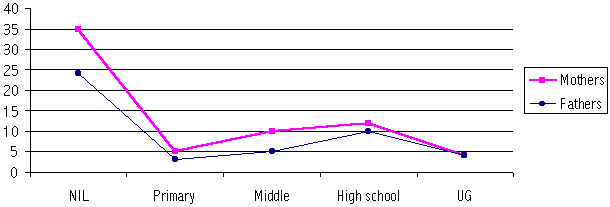Family Background
Shanti Bhavan researched the families of the children over a period
of 5 months. The objective was to ascertain the socio - economic profile
of each family. This study will enable us to meet the needs of the children's
communities in a constructive way. The pediatrician who is also a specialist
in public health and the clinical psychologist tabulated the results
of the study. Their findings are cited here.
Results: Sixty eight of the seventy two children in the first
three grade levels were studied at the time of writing this report.
The remaining two children are orphans who have no family members. The
families were situated in rural areas, institutions and urban slums.
Some of the results highleted were: Religion: Sixty percent (41 out
of 68 children) of the families are Hindu, 38.2% are Christian and 1.5%
are Muslim.
Caste: Both Christian and Muslims do not have any sub-castes.
Out of the remaining Hindu families, the break up of castes are:
| Caste |
No. of Families (%) |
| Adi Dravida |
10 (14.7) |
| Boyer |
7 (10.3) |
| Reddy |
5 (7.4) |
| Gownder |
4 (5.9) |
| Naidu |
4 (5.9) |
| Kuruvan |
3 (4.4) |
| Backward Caste |
1 (1.5) |
| Chetty |
1 (1.5) |
| Dhobi |
1 (1.5) |
| Uppar |
1 (1.5) |
| Vanniar |
1 (1.5) |
| Gold Smith |
1 (1.5) |
| Ghola |
1 (1.5) |
Family type: In India, the various types of families are defined
as:
-
Nuclear: consists of parents and children
-
Joint : many sublines with their families live together
in the same household with their parents
-
Extended : here the family has one of their parents
staying with them
-
Single parent : either mother or father with their
children
-
Orphan : no parents living
The children of Shanti Bhavan come from the following kinds of families:
Family Size
The family size took into account the children studying in Shanti
Bhavan
Educational Status of Parents:
It was found that most of the families had parents who had not studied
at all.

Occupation
Father's occupation: Out of the 68 families studied, only 44
families had fathers. Their occupations varied from being farmers to
no occupation at all.
| Occupation |
Number of Fathers |
| Farmer |
5 |
| Coolie |
15 |
| Mason |
11 |
| Skilled Labourer |
7 |
| Others |
5 |
| Nil |
1 |
Mother's occupation: Sixty five mothers had occupations were
included in the analysis.
| Occupation |
Number of Mothers |
| Farmer |
1 |
| Coolie |
30 |
| Mason |
1 |
| Others |
23 |
| Housewife |
10 |
Family Income
Another variable studied was the average monthly family income of
the families of Shanti Bhavan.
Type of House
Various factors of their homes were studied. This was to determine
the kind of physical environment the families were living in, and if
they had access to the basic facilities.
Type of house:
-
Pucca (cemented house with proper roof, walls, flooring,
e.t.c)
-
Kutcha (no permenant structure, could be tatched)
-
Others (neither tatched no pucca, could be temporary
shelters)
When asked if the house they lived in belonged to them, the following
answers were received:
No. of Rooms: The disturbition of families according to the
number of rooms they had were
-
1 room :38
-
2 rooms :20
-
3 rooms and more: 2
Ventilation: 29 families live in houses where there was some
kind of ventilation in terms of a window or sky light.
Electricity: 43 families live in the houses with access to
electricity.
Kitchen: 44 families had separate cooking areas from their
living space in their homes.
Bathroom: 21 families had access to a toilet facility
Piped water: 36 of the families had access to piped water supply
Water supply: 14 families had adequate access to water supply
Drainage: 21 of the families had drinage facilities connected
to their houses to dispose of water waste
Garbage disposal facility: Only 12 families disposed of their
garbage in a garbage disposal facility
Animals in house: 8 families had animals living inside the
house
Assets: The different assets studied were land, vehicles and
household assets
Land: 10 of the 68 families owned some land. This could either
be in their own names or in the joint family. Out of ten families, 5
families owned 1 acre of land, 3 families owned 2 acres of land and
3 families also owned 3 acres of land.
The crops grown on this land were:
-
Groundnut : 5
-
Ragi : 5
-
Vegetables : 1
-
Mulberry : 2
8 families owned some form of transport, 6 families owned their own
livestock and 4 families were involved in saving money.
Household assets: Many families had one or another household
asset
Ration card: 32 of the 68 families owned a ration card which
would enable them to buy food grains through the public distribution
system. The others bought all their foodstuff through retail outlets.
All the families were asked to describe their feelings about having
their child in Shanti Bhavan. The result was unanimously positive, and
they were happy with the level of progress and achievement they had
seen in their children over the last year. In order to determine if
any family had any specific needs that could be addressed by Shanti
Bhavan, we asked them in what way could their lives be inproved? Some
of the needs could be classified as:
-
Finiancial : 34 families
-
Emotional : 9 families
-
Medical : 6 families
Special note: Practically all our children come from families / backgrounds classified as "Scheduled Castes" (dalits) or "Backward Castes". At the time of enrollment of children, all familes are below the poverty line.






























